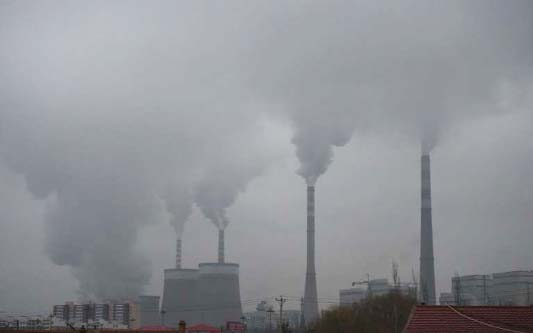
AFP, Paris :
Global emissions of carbon dioxide mainly from fossil fuel burning will rise 2.7 percent in 2018, scientists said on Wednesday, signalling a world “completely off course” in the fight against climate change.
Last year, CO2 pollution increased by 1.6 percent after a three-year hiatus that raised hopes manmade greenhouse gas emissions had finally peaked despite an expanding world economy.
“This growth in global CO2 emissions puts the goals set out in the Paris Agreement in jeopardy,” lead author Corinne Le Quere, director of the Tyndall Centre of Climate Change Research at the University of East Anglia, said in a statement.
“It is not enough to support renewables,” she added. “Efforts to decarbonise need to be expanded throughout the economy.”
The findings, co-authored by a team of nearly 80 scientists, were published in the journal Open Access Earth System Science Data.
Rapid deployment of solar and wind power, along with gains in energy efficiency, have been outpaced by growth in demand for freight, personal transport, shipping, and aviation, the research showed.
The 2015 Paris climate treaty calls for capping global warming at “well below” two degrees Celsius (3.6 degrees Fahrenheit), a goal that scientists say could soon slip out of our grasp if planet-warming continues to climb.
Even a 2C ceiling above pre-industrial levels may not be enough to avoid catastrophic impacts, the UN’s climate science panel concluded in a landmark report in October. A single degree of warming to date has seen a rise in deadly heatwaves,
droughts, floods, and superstorms made worse by rising seas.
“Emissions will continue to rise, rhetoric is increasing but ambition is not – we are completely off course,” said co-author Glen Peters, research director at the Centre for International Climate and Environmental Research in Oslo. “While there has been positive progress on clean energy and electric vehicles, this is currently too small to impact the onward march of fossil fuels.”
The UN Intergovernmental Panel on Climate Change (IPCC) has said that CO2 emissions must drop 50 percent by 2030 – and reach “net zero”, with no additional leakage into the atmosphere – by 2050 if the rise in Earth’s temperature is to be checked at the safer limit of 1.5C.
The uncertainty range for the 2.7 percent increase is 1.8 to 3.7 percent.
Fluctuations in global emissions over the last five or six years have tracked changes in coal consumption, the study revealed.
In particular, “the trends have a lot to do with the ups and downs of coal use in China,” Le Quere told journalists in Paris.
Globally, coal-fired power accounts for 40 percent of CO2 emissions, and more than two-fifths of the world’s electricity.
Oil and gas use have grown almost unabated over the last decade.
China’s emissions accounted for 27 percent of the global total, and will likely show growth of 4.7 percent in 2018.
Global emissions of carbon dioxide mainly from fossil fuel burning will rise 2.7 percent in 2018, scientists said on Wednesday, signalling a world “completely off course” in the fight against climate change.
Last year, CO2 pollution increased by 1.6 percent after a three-year hiatus that raised hopes manmade greenhouse gas emissions had finally peaked despite an expanding world economy.
“This growth in global CO2 emissions puts the goals set out in the Paris Agreement in jeopardy,” lead author Corinne Le Quere, director of the Tyndall Centre of Climate Change Research at the University of East Anglia, said in a statement.
“It is not enough to support renewables,” she added. “Efforts to decarbonise need to be expanded throughout the economy.”
The findings, co-authored by a team of nearly 80 scientists, were published in the journal Open Access Earth System Science Data.
Rapid deployment of solar and wind power, along with gains in energy efficiency, have been outpaced by growth in demand for freight, personal transport, shipping, and aviation, the research showed.
The 2015 Paris climate treaty calls for capping global warming at “well below” two degrees Celsius (3.6 degrees Fahrenheit), a goal that scientists say could soon slip out of our grasp if planet-warming continues to climb.
Even a 2C ceiling above pre-industrial levels may not be enough to avoid catastrophic impacts, the UN’s climate science panel concluded in a landmark report in October. A single degree of warming to date has seen a rise in deadly heatwaves,
droughts, floods, and superstorms made worse by rising seas.
“Emissions will continue to rise, rhetoric is increasing but ambition is not – we are completely off course,” said co-author Glen Peters, research director at the Centre for International Climate and Environmental Research in Oslo. “While there has been positive progress on clean energy and electric vehicles, this is currently too small to impact the onward march of fossil fuels.”
The UN Intergovernmental Panel on Climate Change (IPCC) has said that CO2 emissions must drop 50 percent by 2030 – and reach “net zero”, with no additional leakage into the atmosphere – by 2050 if the rise in Earth’s temperature is to be checked at the safer limit of 1.5C.
The uncertainty range for the 2.7 percent increase is 1.8 to 3.7 percent.
Fluctuations in global emissions over the last five or six years have tracked changes in coal consumption, the study revealed.
In particular, “the trends have a lot to do with the ups and downs of coal use in China,” Le Quere told journalists in Paris.
Globally, coal-fired power accounts for 40 percent of CO2 emissions, and more than two-fifths of the world’s electricity.
Oil and gas use have grown almost unabated over the last decade.
China’s emissions accounted for 27 percent of the global total, and will likely show growth of 4.7 percent in 2018.

